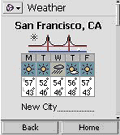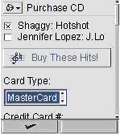Microbrowser Battles
Back to Contents of Issue: July 2001
|
|
||||
|
by Daniel Scuka |
||||
REMEMBER THE DESKTOP BROWSER wars of the '90s? The same hypercompetition is shaping up on the cellphone and other small intelligent devices, only this time the campaigns are being fought in stealth mode in your pocket. But last decade's browser wars offer few clues as to how the microbrowser battle on the tiny screen will play out. The OS on portable devices is far less visible to -- and not chosen by -- the end-user, and there is little scope for one particular browser to be bundled with an OS.
Today, the two dominant players in the Japan cellphone browser market are Access and Openwave. Access is based in Tokyo (see "Small-Time Visionary"), Openwave in Silicon Valley. The latter is in fact a mobile-software giant formed last year by the merger of Software.com and Phone.com. The Access Compact NetFront microbrowser is deployed on the majority of i-mode phones, which means it has the dominant market share of wireless information service subscribers worldwide. But Access is small, in the red, and only recently opened a US office. Furthermore, unlike Openwave, it doesn't (yet) offer a complete end-to-end solution: meaning it doesn't make the mobile wireless gateway that the carrier installs in its network center to handle the flow of data to and from the phones. In contrast, Openwave's UP.Browser appears on most phones that use WAP (Wireless Application Protocol) to access the Web, including those deployed in Europe and the US and by No. 2 Japan carrier KDDI/Au's EZWeb service (7.2 million subscribers as of May 1). As of June 2000, Openwave says it had licensed the UP.Browser to 35 phone makers worldwide who had launched over 80 browser phones and had 200 more on the drawing board. Furthermore, Openwave is one of the few large software integrators (along with Ericsson, Nokia, Logica, and a couple others) that can provide the sophisticated gateway that operators need to launch lucrative wireless information services -- and Openwave's browser is intimately integrated with the gateway architecture. In fact, in many markets, the company provides the browser for free, while encouraging deep-pocketed wireless carriers to shell out for the gateway solution, which now includes synchronization, unified messaging, and voice recognition intelligence. The aim is to lock in carriers with ever more sophisticated gateway services and then bill them based on a per-user licensing model. As the popularity of browser phone-based services takes off, so should Openwave's revenues. "Our strength is the gateway," says Masaaki Yamamoto, senior manager at Openwave Japan. Unlike Openwave's free browser model, Access earns 90 percent of its revenue solely from browser business (and this revenue stream is rumored to be small), and may have a tough job convincing overseas operators to pay for its browser when Openwave is giving its away for free. Furthermore, Openwave, through its Phone.com and Software.com antecedents, claims a stellar line-up of global telecom customers for its full range of software technology, including Bell Atlantic, BT Cellnet, GTE, AT&T, and Hutchison -- a client list that Japan-focused Access can only drool over.
But it would be a big mistake to write off Access. CTO and co-founder Tomihisa Kamada was the lead author of the original cHTML (compact Hypertext Markup Language) specification submitted to the Worldwide Web Consortium (the W3C) in 1998. cHTML is one major factor behind the success of i-mode, and Kamada has helped DoCoMo spark the growth of a vigorous developer community centered on i-mode. DoCoMo could twist overseas partners' arms to adopt Access's browsers instead of other offerings. The NetFront and Compact NetFront browsers have been supplied to such mobile device makers as Compaq (Presario 213), Casio (Cassiopeia), Sega (Dreamcast), Alpine (various stereo systems), and Panasonic (Webphone ED-18). Access is actively developing new, technically sophisticated versions of its browser lineup that will integrate Java, SSL security, and multimedia capability. In April, Access signed a platform partner agreement with San Francisco--based idrive.com to build online storage functionality into future versions of its browsers -- a key selling point for the US corporate mobile market. With Kamada's engineering expertise and DoCoMo's help, the tiny firm may be able to dance circles around any lumbering competitor, especially if consumers demand the type of multimedia audio and video download that Access's browsers will provide. By fall this year, both Openwave and Access are due to release updated versions of their microbrowsers, both of which will be able to read each other's languages. This means the i-mode vs. WAP debate is effectively over. Ultimately, it's the third-party developers who will decide which microbrowser prevails. End-users, for their part, won't have to care one way or the other.
|
||||
Note: The function "email this page" is currently not supported for this page.







